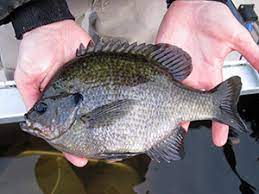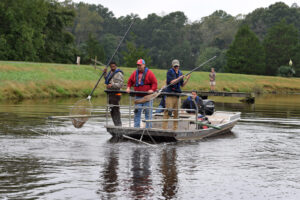Electrofishing: A Key Tool For A Healthy And Successful Fishery
A tailored and comprehensive approach for managing your unique fish population using a variety of proven tools and techniques is key for creating a successful and healthy fishery. Once your goals are determined, factors limiting fish health and growth need to be evaluated and addressed. These factors may include physical and chemical habitat, water quality, predator to prey ratios, and the proper fish species and composition. When these variables are properly balanced, you can create a stable and productive aquatic community. Throw in good monitoring and genetics, and you have the fundamentals to produce a trophy fishery.

One of the most common methods used by biologists to sample and analyze a fishery is called electrofishing, and if you go fishing in your pond, it is important to understand and learn about its benefits. Electrofishing is a fish sampling tool used to gather fish population data, allowing pond managers to make accurate decisions and improve fisheries management techniques. Using an electrofishing boat, electricity produced from a generator is converted from alternating current to direct current, to allow it to be safer for the fish. It then travels through wires to the bow of the boat where it passes from the cathode through the water to the anode. The electric field produced affects a relatively small area of the water in front of the vessel (usually about 8 by 10 feet wide and 6 feet deep) where fish are momentarily stunned and safely collected with dip nets. The fish are placed in a live well on the boat where length and weight data is recorded, observations are made, and then the fish are released, without harm, back into their environment. The data provides insight into current and future issues, giving pond managers the needed facts to make a pond productive or balanced, or to keep it that way. In addition to collecting data, undesired species of fish or overpopulated size classes of predators can be removed from the waterbody. Electrofishing is the best method to monitor and adjust your fish population dynamics and is a vital step in meeting your fisheries goals.
 Depending on the goals of the study, the fish can also be aged. Aging fish is nearly identical to aging a tree. Like a tree, fish are always producing layers of growth. The two primary ways to age fish are to either use scales from the fish or remove the otolith (inner ear bone). During times of slow growth, such as winter, these layers of growth are closer together forming a dark line. In the summer, when fish are growing more quickly, these layers of growth spread out resulting in a lighter area.This allows biologists to determine how may winters and summers a fish has lived. The most amazing part about this is that you can actually determine how many inches the fish grew each year of its life using basic mathematical calculations. This fish growth knowledge can be very important in understanding your lake or pond’s history and current condition.
Depending on the goals of the study, the fish can also be aged. Aging fish is nearly identical to aging a tree. Like a tree, fish are always producing layers of growth. The two primary ways to age fish are to either use scales from the fish or remove the otolith (inner ear bone). During times of slow growth, such as winter, these layers of growth are closer together forming a dark line. In the summer, when fish are growing more quickly, these layers of growth spread out resulting in a lighter area.This allows biologists to determine how may winters and summers a fish has lived. The most amazing part about this is that you can actually determine how many inches the fish grew each year of its life using basic mathematical calculations. This fish growth knowledge can be very important in understanding your lake or pond’s history and current condition.

Management implications that result from the electrofishing process are tailored to the goals of the client. One benefit to electrofishing, aside from collecting fish data, is having a biologist examine the waterbody to understand why it is in its current state. Knowing that the fish population is out of balance is one thing, but understanding how to fix the problem and make necessary improvements to keep the fishery from reverting back to its old ways is equally important. For owners looking to restore a fishery to a balanced state, an initial survey will provide the needed information to make improvements. The frequency in which a waterbody has an electrofishing study completed is directly related to the goals of the waterbody and the available budget. Those who want a balanced, healthy fishery should consider a 2-5 year rotation between studies, where as those who want a trophy fishery, or want to make big improvements in a relatively short period of time, will require electrofishing once or twice per year.
The spring and fall seasons are the perfect times to conduct an electrofishing study. Based on scientific research, these are the best times of year when water temperatures allow for the most accurate collection of fisheries data.
For more information or to set up a detailed electrofishing analysis to assess the heath of your fishery and help you meet your fisheries goals, contact SOLitude Lake Management to speak with an expert fisheries biologist today. 888-480-5253 or [email protected]. Services available in the southeast and mid-Atlantic states. Aquatic products and consultation are available nationwide.









